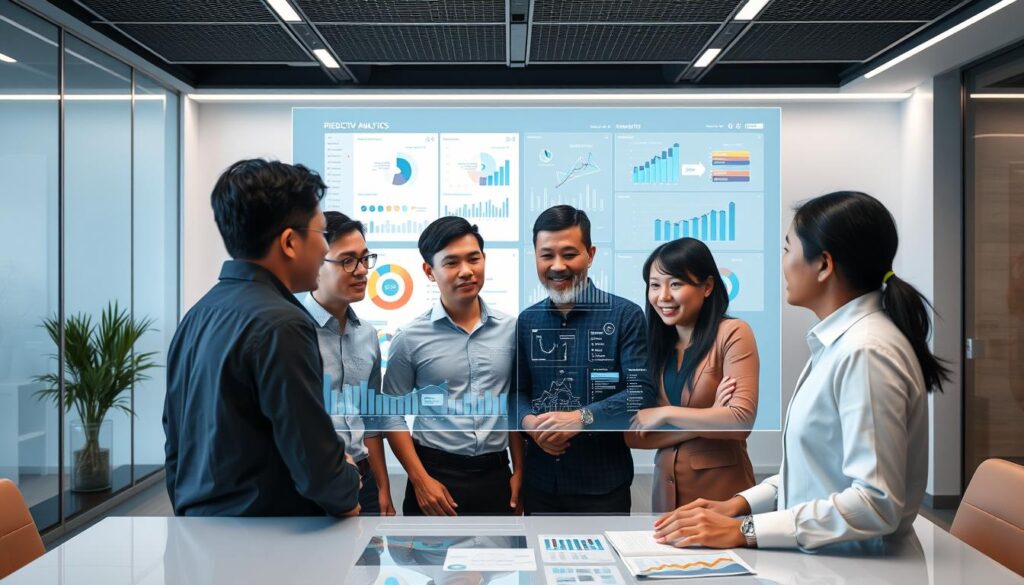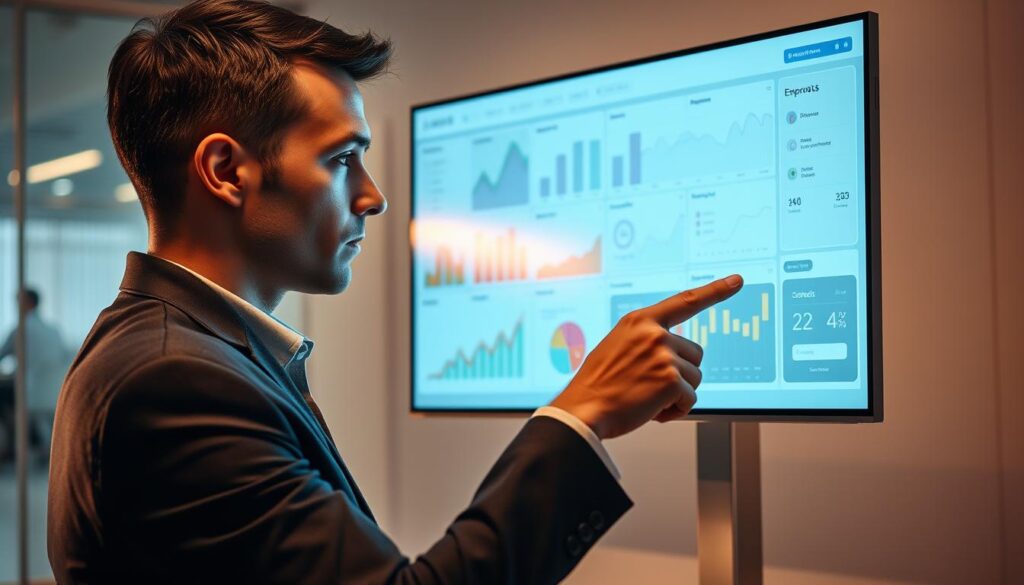What if the secret to keeping your best employees lies in the data your company generates? Companies in the Philippines face a big challenge with employee turnover. But, using AI in employee retention strategies could be the solution.
AI helps businesses change how they manage their workforce. It predicts when employees might leave and offers them chances to grow. This article shows how AI can help you keep your employees happy and loyal.
Key Takeaways
- AI offers data-driven insights to improve employee retention strategies.
- Understanding turnover trends can help personalize employee experiences.
- AI-driven tools identify at-risk employees before they decide to leave.
- Personalized career development paths enhance employee satisfaction.
- Recognition systems powered by AI can boost retention rates significantly.
- Integrating HR and AI technologies streamlines processes for a better employee experience.
The Role of AI in Employee Retention
Employee turnover is a big problem in many industries, including the Philippines. The fight for skilled workers is tough. Companies need to keep up by using smart strategies to keep employees. AI helps by using data to understand and keep workers.
Understanding Employee Turnover Trends
It’s key for companies to know about employee turnover. By looking at past data and checking how happy employees are, they can spot why people leave. AI makes it easier to understand what employees think. This helps companies to act before it’s too late.
Importance of Retention in Today’s Competitive Market
Keeping employees is more than just a goal today. High turnover costs a lot, lowers productivity, and hurts morale. Using AI, companies can make sure employees feel important and heard. This makes employees more loyal, which is good for the company’s future.
Predictive Analytics for Early Intervention
In today’s fast-paced world of human resources, using predictive analytics is key. Companies are turning to advanced AI to spot employees at risk early on. By looking at how employees act and engage, they can tackle problems before they get worse. This helps keep more employees on board.
How AI Identifies At-Risk Employees
AI can dig through big data to find trends and connections that humans might miss. For example, changes in how much work is done, how often people are absent, and what they say in feedback can hint at problems. This info helps HR teams act fast to keep employees happy and working well.
Actionable Insights from Employee Data
The insights from predictive analytics help create strategies to keep employees. Companies can focus on what each person needs, making plans that really work. This makes work better for everyone and shows that employees are truly important.

Personalized Career Development Paths
AI is changing how companies help employees grow in their careers. It creates plans that match each person’s skills and dreams. This way, learning is more focused and meets both personal and company goals.
This approach helps employees grow and feel more satisfied with their jobs. It also makes them more likely to stay with the company.
Creating Tailored Learning Opportunities
AI helps companies understand what each employee needs to improve. It looks at performance data to suggest the right training. This ensures employees get the support they need.
By making learning fit each person, companies keep their teams motivated. This leads to a more engaged and productive workforce.
Examples of Successful Personalized Development
Many companies have seen great results from using AI for career growth. Spotify is a great example. They have a talent marketplace called Echo that suggests jobs based on an employee’s skills and interests.
This helps employees find roles that are a good fit for them. It boosts job satisfaction and helps the company succeed.
Performance Management & Engagement
The world of performance management is changing fast, thanks to new tech. Companies using AI for feedback see big improvements. They move from yearly reviews to ongoing updates, keeping everyone on track and informed.
AI-Driven Feedback Mechanisms
AI makes feedback better and more frequent. It combines peer reviews, manager feedback, and self-assessments for a full picture. This helps tailor training and growth plans for each employee.
Regular, helpful feedback boosts a culture of always getting better. It makes employees more engaged. AI makes feedback timely and spot-on, helping improve performance.
Continuous Performance Monitoring
Keeping an eye on performance all the time is key to keeping employees happy. AI helps spot issues early and helps fix them. This makes employees feel seen and valued.
Those who monitor performance closely often feel more satisfied with their jobs. This leads to better retention rates. In today’s competitive world, keeping a happy team is essential for success.

Enhanced Onboarding Experiences with AI
AI onboarding changes how companies welcome new employees. It uses technology to make onboarding fit each person’s needs. This helps keep employees happy from the start.
Personalizing onboarding makes new hires feel at home. It also helps them use their skills better. This makes the onboarding process better for everyone.
Tailoring Onboarding to Individual Needs
Customized onboarding means each new employee gets the right help. Companies use AI to learn about each person’s background and how they learn best. This makes it easier for them to get started.
Getting the right support early on makes employees more engaged. They feel more connected to the company. This leads to a happier and more loyal team.
Data-Driven Insights That Shape Onboarding Processes
Data is key to making onboarding better. Companies use it to see what works and what doesn’t. They then make changes to improve the experience.
By using data, companies can make onboarding more effective. It helps new employees do their jobs well and stay with the company long-term. AI onboarding is all about preparing for the future.
| Customized Onboarding Feature | Impact on Employee Retention |
|---|---|
| Personalized Training Modules | Enhances skill proficiency and confidence |
| Mentees from Similar Backgrounds | Encourages community and support |
| Flexible Learning Paths | Accommodates different learning styles |
| Regular Feedback Loops | Identifies adjustments needed for improvement |
Real-Time Employee Feedback Tools
In today’s fast-paced work environment, real-time employee feedback tools are key. They help understand and address employee sentiments quickly. Organizations that use these tools get immediate insights into employee morale. This lets managers act fast to any concerns.
Using sentiment analysis tools helps companies accurately interpret feedback. This way, they can gauge employee sentiments well.
Sentiment Analysis for Immediate Insights
Sentiment analysis tools quickly process employee feedback. They reveal feelings that might not be obvious at first. This technology turns qualitative feedback into data that guides management strategies.
By understanding these sentiments, companies can tackle issues quickly. This boosts both workplace satisfaction and loyalty.
Improving Engagement Through Open Communication
Real-time feedback tools show a commitment to employee growth. They foster a culture of open communication. This makes employees feel valued and heard.
This active engagement boosts morale. It supports a culture that thrives on trust and cooperation. Companies that promote strong employee communication do better at keeping employees and growing.
For more on how to overcome resistance to AI, visit strategies for overcoming resistance to AI.

Integrating HR and AI Technologies
Companies are now using AI HR systems to make their workflows better and improve how employees feel at work. Integrating HR technology is key to updating HR processes. It helps companies quickly meet their workforce’s needs. AI helps businesses get important insights and make their operations smoother.
This makes the workplace more engaging. It benefits both employees and employers.
Utilizing AI-Powered HR Systems
AI-powered HR systems do many things, from finding the right candidates to keeping employees. They use advanced analytics to find the best candidates. This is based on their skills and how well they fit the company.
These systems also use machine learning to look at employee data. This helps predict future hiring needs and improve how the company manages its workforce.
Streamlining HR Processes for Better Employee Experience
Good HR technology integration makes HR tasks easier. This lets HR professionals focus more on making employees happy and helping them grow. By automating simple tasks, companies can improve their efforts to make employees feel valued.
As a result, employees are more engaged and happy in their jobs. This leads to higher retention rates.
| Feature | Traditional HR | AI-Powered HR Systems |
|---|---|---|
| Recruitment Process | Manual screening and interviews | AI-driven candidate analysis and matching |
| Employee Feedback | Annual reviews | Real-time sentiment analysis |
| Data Analysis | Post-hoc reporting | Predictive modeling and insights |
Recognition and Reward Systems
Employee recognition is key to a positive work culture. AI recognition programs make it easier to thank employees for their hard work. This way, everyone gets the appreciation they deserve right away.
AI-Driven Recognition Programs
AI recognition programs use smart algorithms to spot and celebrate employee achievements. They track how well employees do and show off their contributions. This boosts morale and makes everyone want to do their best.
The Impact of Recognition on Retention Rates
A good recognition system can really help keep employees. Feeling valued makes people more likely to stay. In fact, companies that thank their employees often see fewer people leaving.
As Asia’s companies start using AI recognition, they create a place where hard work is rewarded. This leads to happier, more loyal employees.

Mental Health Support through AI
Supporting employee mental health is crucial today. AI tools can help a lot. They offer quick help and encourage talking about mental health. This makes the workplace better for everyone.
AI chatbots can give employees the help they need fast. They can talk about stress, anxiety, or feeling overwhelmed. This support is key to keeping employees happy and healthy at work.
Studies show that focusing on mental health helps keep employees. A big 92% of workers feel more loyal to companies that care about their mental health. In the Philippines, using AI for mental health support can really improve work culture.
These tools can adjust to each person’s needs. This makes sure everyone feels supported at work. It’s a big step towards a healthier work environment.
Conclusion
In the Philippines, companies face big challenges in keeping their employees. Using AI in keeping employees is a game-changer. It helps them understand their team better and lower the chance of losing workers.
Improving how they manage work and supporting mental health are key. These steps make employees happier and more loyal. This way, businesses can stay ahead in the changing job market.
To succeed today, companies must invest in AI. It’s not just a choice, it’s a must. AI helps tackle the problem of losing workers. It also makes sure employees feel important and cared for.

